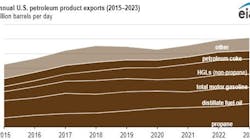Sam Fletcher
Senior Writer
HOUSTON, Oct. 6 -- Energy prices continued to tumble Oct. 5 because of market perceptions of decreased demand in the face of recently high costs.
However, Paul Horsnell with Barclays Capital Inc., London, said, "The supply-side deficits in the US oil product market remain cavernous, with demand effects dwarfed by the size of the product gaps."
In an Oct. 5 report, Horsnell said: "The cumulative loss of crude oil output due to Katrina and Rita is now close to 50 million bbl and is likely ultimately to extend beyond 100 million bbl. We now expect the cumulative level of forgone refinery output to close in on 200 million bbl, with the cumulative reduction in gasoline output alone now expected to stretch towards 100 million bbl. The hit to the supply side is very significant, including the lowest US crude oil production for over 60 years, very low refinery runs, and a [year-over-year] reduction of over 1 million b/d in gasoline output. US oil inventories fell by 8.8 million bbl relative to their normal seasonal pattern in the latest week, taking oil product inventories below their 5-year average level. All that, and the greater part of the disruption to oil products supply is not yet in the data."
He concluded, "Given that toll of supply-side trouble, together with the even more alarming tightness in natural gas, one might then wonder as to why the fast money has been so quick to sell the energy complex. The reason is demand pessimism, based on some confusions about relative magnitudes and some overly downbeat views on the US economy. In reality, demand is not close to compensating for the supply-side deficits."
US supplies fall
The Energy Information Administration reported Oct. 5 that US commercial stocks of crude dipped by 300,000 bbl to 305.4 million bbl during the week ended Sept. 30. Gasoline inventories plunged by 4.3 million bbl to 195.5 million bbl, and distillate fuel inventories dropped 5.6 million bbl to 128 million bbl during the same period, with a sharp decline in diesel fuel offsetting a slight rise in heating oil (OGJ Online, Oct. 5, 2005).
Of the 16 Gulf Coast refineries that shut down ahead of Hurricane Rita, 9 are still inactive, including 7 in the Port Arthur and Lake Charles areas and 2 in the greater Houston area. An additional 4 refineries in the New Orleans area were disabled by Hurricane Katrina, "amounting to a total of over 3.1 million b/d of refining capacity that is currently offline," the US Department of Energy said Oct. 5. "This accounts for nearly 1.4 million b/d of gasoline, about 750,000 b/d of distillate fuel, and nearly 400,000 b/d of jet fuel that is not being produced as long as these refineries remain shut down."
Chevron Corp. said Oct. 6 it initiated start-up procedures for its 325,000 b/d refinery at Pascagoula, Miss., which was shut down prior to Hurricane Katrina. The refinery could return to normal operations by the end of the month, ahead of previous estimates, said company officials.
The US Minerals Management Service said crews still had not returned to 304 platforms and 7 rigs in the Gulf of Mexico as of Oct. 5. It reported 1.3 million b/d, or 86.7%, of crude production from the gulf is still shut in, as is 6.9 bcfd, or 68.95%, of natural gas production. The cumulative amount of production lost since Aug. 26 now stands at 47.8 million bbl of crude and 233.4 bcf of gas, MMS said.
In a survey of status of producing wells onshore and in state waters in a 38-parish region, the Louisiana Office of Conservation said Oct. 5 that 410.2 MMcfd of natural gas production has been restored, although 34.2% of the wells were reported still shut-in. The gas production capacity of the 38 parishes is estimated at 2.2 bcfd, based on the average production reported January-May. However, Louisiana officials said they have not received information on 52.6% of the oil and gas wells in the region in the current survey.
DOE said 20 natural gas processing plants in Texas, Louisiana, and Mississippi are inactive now, down from 26 at the end of September. Officials blamed external factors, including lack of electric power or gas supplies, for idling 9 of those plants, while the other 11 suffered storm damage.
Sabine Pipeline LLC, operator of the Henry Hub, La., gas collection point, lifted its force majeure at a third pipeline interconnect Oct. 5 but will continue its force majeure for all remaining points until further notice. There are 14 pipelines with interconnections at the Henry Hub. The New York Mercantile Exchange lifted the force majeure condition for both September and October 2005 natural gas futures contract delivery obligations, effective Oct. 5 (OGJ Online, Oct. 5, 2005).
Trunkline LNG in Lake Charles, La., said it is capable of discharging LNG vessels at its terminal. The Calcasieu Ship Channel and Industrial Canal have been cleared for LNG vessel transit.
Energy prices
The November contract for benchmark US sweet, light crudes fell by $1.11 to $62.79/bbl Oct. 5, the lowest price for a front-month crude contract on NYMEX in 2 months. The December position retreated by $1.07 to $62.69/bbl. Gasoline for November delivery plunged by 10.79¢ to $1.91/gal as traders shrugged off the sharp decline in gasoline inventories reported by EIA. Heating oil for the same month lost 3.49¢ to $2.01/gal. The November natural gas contract closed at $14.18/MMbtu, down 4.1¢ in profit-taking after hitting an intraday record high of $14.75/MMbtu on NYMEX.
In London, the November contract for North Sea crude dropped $1.10 to $60.12/bbl on the International Petroleum Exchange. However, gas oil for October rose by $6.75 to $614.50/tonne.
The average price for the Organization of Petroleum Exporting Countries' basket of 11 benchmark crudes declined by 62¢ to $55.86/bbl Oct. 5.
Contact Sam Fletcher at [email protected].
